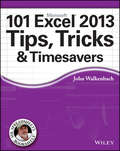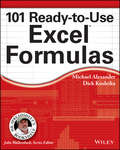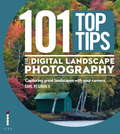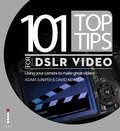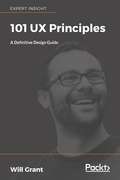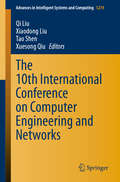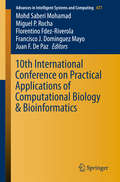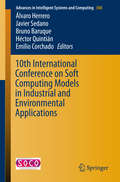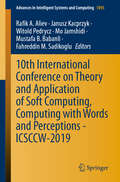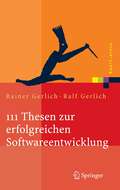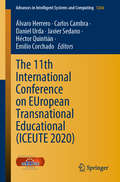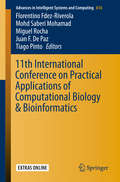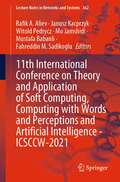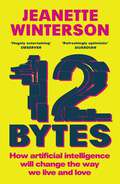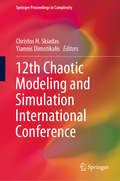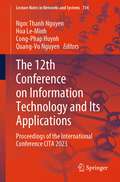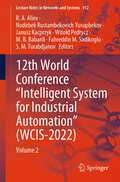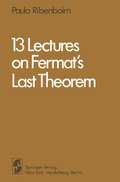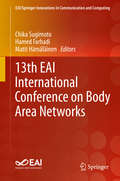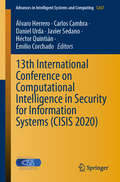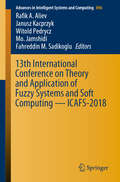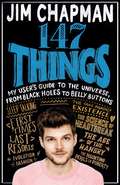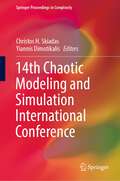- Table View
- List View
101 Excel 2013 Tips, Tricks and Timesavers
by John WalkenbachGet the most out of Excel 2013 with this exceptional advice from Mr. Spreadsheet himself! Excel 2013 is excellent, but there's lots to learn to truly excel at Excel! In this latest addition to his popular Mr. Spreadsheet's Bookshelf series, John Walkenbach, aka "Mr. Spreadsheet," shares new and exciting ways to accomplish and master all of your spreadsheet tasks. From taming the Ribbon bar to testing and tables, creating custom functions, and overcoming "impossible" charts, mixing nesting limits, and more, 101 Excel 2013 Tips, Tricks, & Timesavers will save you time and help you avoid common spreadsheet stumbling blocks. Reveals ways to maximize the power of Excel to create robust applications Draws on John Walkenbach's years of experience using Excel and writing more than 50 books Shares tips and tricks for dealing with function arguments, creating add-ins, using UserForms, working with dynamic chart data, and changing data entry orientation Provides shortcuts and helpful techniques for sorting more than three columns, entering fake data for testing purposes, and setting up powerful pivot tables 101 Excel 2013 Tips, Tricks, & Timesavers is packed with information that you need to know in order to confidently and seamlessly master the challenges that come with using Excel!
101 Ready-to-Use Excel Formulas
by Michael Alexander Richard KusleikaMr. Spreadsheet has done it again with 101 easy-to-apply Excel formulas 101 Ready-to-Use Excel Formulas is filled with the most commonly-used, real-world Excel formulas that can be repurposed and put into action, saving you time and increasing your productivity. Each segment of this book outlines a common business or analysis problem that needs to be solved and provides the actual Excel formulas to solve the problem—along with detailed explanation of how the formulas work. Written in a user-friendly style that relies on a tips and tricks approach, the book details how to perform everyday Excel tasks with confidence. 101 Ready-to-Use Excel Formulas is sure to become your well-thumbed reference to solve your workplace problems. The recipes in the book are structured to first present the problem, then provide the formula solution, and finally show how it works so that it can be customized to fit your needs. The companion website to the book allows readers to easily test the formulas and provides visual confirmation of the concepts presented. Teaches you how to implement the required Excel formula Explains and details how the formulas work Lets you reuse or customize the given formula to address your particular needs Helps you make the formulas a regular part of your new, more efficient workflow Specific real-world scenarios are used to demonstrate how to most effectively apply Excel and its powerful formulas to complete tasks faster and with greater accuracy than ever before. Now you can save time, automate, and be more efficient and productive with 101 Ready-to-Use Excel Formulas.
101 Ready-to-Use Excel Formulas
by Michael Alexander Richard KusleikaMr. Spreadsheet has done it again with 101 easy-to-apply Excel formulas 101 Ready-to-Use Excel Formulas is filled with the most commonly-used, real-world Excel formulas that can be repurposed and put into action, saving you time and increasing your productivity. Each segment of this book outlines a common business or analysis problem that needs to be solved and provides the actual Excel formulas to solve the problem—along with detailed explanation of how the formulas work. Written in a user-friendly style that relies on a tips and tricks approach, the book details how to perform everyday Excel tasks with confidence. 101 Ready-to-Use Excel Formulas is sure to become your well-thumbed reference to solve your workplace problems. The recipes in the book are structured to first present the problem, then provide the formula solution, and finally show how it works so that it can be customized to fit your needs. The companion website to the book allows readers to easily test the formulas and provides visual confirmation of the concepts presented. Teaches you how to implement the required Excel formula Explains and details how the formulas work Lets you reuse or customize the given formula to address your particular needs Helps you make the formulas a regular part of your new, more efficient workflow Specific real-world scenarios are used to demonstrate how to most effectively apply Excel and its powerful formulas to complete tasks faster and with greater accuracy than ever before. Now you can save time, automate, and be more efficient and productive with 101 Ready-to-Use Excel Formulas.
101 Top Tips for Digital Landscape Photography: Capturing Great Landscapes With Your Camera (101 Top Tips Series)
by Carl Heilman IIA comprehensive guide to improving your landscape photography by one of today's foremost landscape photographers.Landscape photography is perhaps the single most popular genre among DSLR owners. In 101 Top Tips for Digital Landscape Photography, experienced professional landscape guru Carl Heilman II gives the benefit of a lifetime spent shooting spectacular wilderness and mountain shots, offering a host of targeted tips and tricks that will allow photographers of all abilities to lift their landscape work to the next level.The reader will learn how to harness natural drama, use difficult lighting situations to your advantage and capture unusual perspectives, all the while benefiting from Carl's clear instruction and beautiful landscape work.
101 Top Tips for DSLR Video: Using your camera to make great videos
by Adam Juniper David NewtonFollowing the arrival of game-changing new cameras from Nikon and Canon, the hottest area in the world of photography has been combining high-definition video capability with all the advantages of SLR's interchangeable lenses. For the first time, full cinematic creativity is within anyone's grasp.With its tips-based structure, this book can be dipped into for reference for movie-makers of any background, or read cover to cover for a complete course in movie-making. With four case studies from real-world professional projects, including a TV advertisement and a music video, 101 Top Tips for DSLR Video provides invaluable guidance for any budding filmmakers.Top Tips for DSLR Video also includes four case studies from real-world professional projects, including a TV advertisement and a music video. Taking you all the way from understanding and choosing the technology, to planning, shooting, editing, and finally publishing your movie, this book contains everything you really need to know about making video with your digital SLR camera.
101 UX Principles: A Definitive Design Guide
by Will GrantLearn from the opinions of a UX expert, evaluate your own design principles, and avoid common mistakes. Key Features Hear insights from an author who was trained by the Nielsen Norman Group Browse over 20 years of collected UX insights Accept or reject 101 thought-provoking opinions on design Challenge your own ideas on UX Book Description There are countless books about designing for the web. They all give multiple routes and options to solving design challenges. Many of them are plain wrong. This has led to an entire generation of designers failing to make interfaces that are usable, software that is intuitive, and products that normal people can understand. 101 UX Principles changes that, with 101 ways to solve 101 UX problems clearly and single-mindedly. The 101 principles are opinionated. They'll rub some designers up the wrong way, but these principles are rooted in 20 years of building for the web. They're not based on theory - they're based on practice. Simply put, they've been proven to work at scale. There's no arguing with that. Following in the footsteps of Jakob Nielsen and Don Norman, this book is the go-to manual for UX professionals, covering everything from passwords, to planning the user journey. Build a deeper understanding of accessible design and implement tried-and-tested strategies in your company. What you will learn Use typography well to ensure that text is readable Design controls to streamline interaction Create navigation which makes content make sense Convey information with consistent iconography Manage user input effectively Represent progress to the user Provide interfaces that work for users with visual or motion impairments Understand and respond to user expectations Who this book is for This book is for UX professionals (freelance or in-house) looking for shortcuts to making software that users intuitively know how to use across web, desktop, and mobile.
101 UX Principles: A Definitive Design Guide
by Will GrantLearn from the opinions of a UX expert, evaluate your own design principles, and avoid common mistakes. Key Features Hear insights from an author who was trained by the Nielsen Norman Group Browse over 20 years of collected UX insights Accept or reject 101 thought-provoking opinions on design Challenge your own ideas on UX Book Description There are countless books about designing for the web. They all give multiple routes and options to solving design challenges. Many of them are plain wrong. This has led to an entire generation of designers failing to make interfaces that are usable, software that is intuitive, and products that normal people can understand. 101 UX Principles changes that, with 101 ways to solve 101 UX problems clearly and single-mindedly. The 101 principles are opinionated. They'll rub some designers up the wrong way, but these principles are rooted in 20 years of building for the web. They're not based on theory - they're based on practice. Simply put, they've been proven to work at scale. There's no arguing with that. Following in the footsteps of Jakob Nielsen and Don Norman, this book is the go-to manual for UX professionals, covering everything from passwords, to planning the user journey. Build a deeper understanding of accessible design and implement tried-and-tested strategies in your company. What you will learn Use typography well to ensure that text is readable Design controls to streamline interaction Create navigation which makes content make sense Convey information with consistent iconography Manage user input effectively Represent progress to the user Provide interfaces that work for users with visual or motion impairments Understand and respond to user expectations Who this book is for This book is for UX professionals (freelance or in-house) looking for shortcuts to making software that users intuitively know how to use across web, desktop, and mobile.
The 10th International Conference on Computer Engineering and Networks (Advances in Intelligent Systems and Computing #1274)
by Qi Liu Xiaodong Liu Tao Shen Xuesong QiuThis book contains a collection of the papers accepted by the CENet2020 – the 10th International Conference on Computer Engineering and Networks held on October 16-18, 2020 in Xi’an, China. The topics focus but are not limited to Internet of Things and Smart Systems, Artificial Intelligence and Applications, Communication System Detection, Analysis and Application, and Medical Engineering and Information Systems. Each part can be used as an excellent reference by industry practitioners, university faculties, research fellows and undergraduates as well as graduate students who need to build a knowledge base of the most current advances and state-of-practice in the topics covered by this conference proceedings. This will enable them to produce, maintain, and manage systems with high levels of trustworthiness and complexity.
10th International Conference on Practical Applications of Computational Biology & Bioinformatics (Advances in Intelligent Systems and Computing #477)
by Mohd Saberi Mohamad Miguel P. Rocha Florentino Fdez-Riverola Francisco J. Domínguez Mayo Juan F. De PazBiological and biomedical research are increasingly driven by experimental techniques that challenge our ability to analyse, process and extract meaningful knowledge from the underlying data. The impressive capabilities of next generation sequencing technologies, together with novel and ever evolving distinct types of omics data technologies, have put an increasingly complex set of challenges for the growing fields of Bioinformatics and Computational Biology. The analysis of the datasets produced and their integration call for new algorithms and approaches from fields such as Databases, Statistics, Data Mining, Machine Learning, Optimization, Computer Science and Artificial Intelligence. Clearly, Biology is more and more a science of information requiring tools from the computational sciences. In the last few years, we have seen the surge of a new generation of interdisciplinary scientists that have a strong background in the biological and computational sciences. In this context, the interaction of researchers from different scientific fields is, more than ever, of foremost importance boosting the research efforts in the field and contributing to the education of a new generation of Bioinformatics scientists. PACBB‘16 hopes to contribute to this effort promoting this fruitful interaction. PACBB'16 technical program included 21 papers spanning many different sub-fields in Bioinformatics and Computational Biology. Therefore, the conference will certainly promote the interaction of scientists from diverse research groups and with a distinct background (computer scientists, mathematicians, biologists). The scientific content will certainly be challenging and will promote the improvement of the work being developed by each of the participants.
10th International Conference on Soft Computing Models in Industrial and Environmental Applications (Advances in Intelligent Systems and Computing #368)
by Álvaro Herrero Javier Sedano Bruno Baruque Héctor Quintián Emilio CorchadoThis volume of Advances in Intelligent and Soft Computing contains accepted papers presented at the 10th International Conference on Soft Computing Models in Industrial and Environmental Applications (SOCO 2015), held in the beautiful and historic city of Burgos (Spain), in June 2015.Soft computing represents a collection or set of computational techniques in machine learning, computer science and some engineering disciplines, which investigate, simulate and analyze very complex issues and phenomena. This Conference is mainly focused on its industrial and environmental applications.After a through peer-review process, the SOCO 2015 International Program Committee selected 41 papers, written by authors from 15 different countries. These papers are published in present conference proceedings, achieving an acceptance rate of 40%.The selection of papers was extremely rigorous in order to maintain the high quality of the conference and we would like to thank the members of the International Program Committees for their hard work during the review process. This is a crucial issue for creation of a high standard conference and the SOCO conference would not exist without their help.
10th International Conference on Theory and Application of Soft Computing, Computing with Words and Perceptions - ICSCCW-2019 (Advances in Intelligent Systems and Computing #1095)
by Rafik A. Aliev Janusz Kacprzyk Witold Pedrycz Mo Jamshidi Mustafa B. Babanli Fahreddin M. SadikogluThis book presents the proceedings of the 10th Conference on Theory and Applications of Soft Computing, Computing with Words and Perceptions, ICSCCW 2019, held in Prague, Czech Republic, on August 27–28, 2019. It includes contributions from diverse areas of soft computing and computing with words, such as uncertain computation, decision-making under imperfect information, neuro-fuzzy approaches, deep learning, natural language processing, and others. The topics of the papers include theory and applications of soft computing, information granulation, computing with words, computing with perceptions, image processing with soft computing, probabilistic reasoning, intelligent control, machine learning, fuzzy logic in data analytics and data mining, evolutionary computing, chaotic systems, soft computing in business, economics and finance, fuzzy logic and soft computing in earth sciences, fuzzy logic and soft computing in engineering, fuzzy logic and soft computing in material sciences, soft computing in medicine, biomedical engineering, and pharmaceutical sciences. Showcasing new ideas in the field of theories of soft computing and computing with words and their applications in economics, business, industry, education, medicine, earth sciences, and other fields, it promotes the development and implementation of these paradigms in various real-world contexts. This book is a useful guide for academics, practitioners and graduates.
111 Thesen zur erfolgreichen Softwareentwicklung: Argumente und Entscheidungshilfen für Manager. Konzepte und Anleitungen für Praktiker (Xpert.press)
by Rainer GerlichZiel dieses Buches ist es, Managern Argumente und Entscheidungshilfen für die Einführung effizienter Techniken der Softwareentwi- lung zu geben, und Praktiker von der Notwendigkeit effizienter Softwaree- wicklung zu überzeugen und Wege zur erfolgreichen - wendung aufzuzeigen. Unter "effizienter Softwareentwicklung" verstehen wir die - setzung von Anforderungen in "qualitativ hochwertige" Software zu "angemessenem" Preis innerhalb "angemessener" Zeit. "Qualitativ hochwertig" steht für fehlerfrei, zuverlässig, robust und voll den Anforderungen entsprechend. Unter "angemessen" verstehen wir minimale Komplexität bei voller Abdeckung der - forderungen, bezahlbar und kurzfristig verfügbar. Im ersten Teil dieses Buches (Kap. 2 - 5) führen wir den Leser hin zum "automatischen Softwareproduktionsprozess", durch P- sentation von Thesen und Analysen. Anleitungen und Beispiele folgen im zweiten Teil (Kap. 6 und 7). Wir schließen mit Betra- tungen zur gesellschaftspolitischen Relevanz einer Technologie, die auf Automation beruht (Kap. 8). Wie in anderen Bereichen, in denen Automation bereits an- wendet wird, haben automatische Softwareproduktionsprozesse Einfluss auf die Arbeitsplätze. Präziser ausgedrückt, es fallen - stimmte Arten von Arbeitsplätzen weg, während andere entstehen. Für Manager und Entwickler, aber auch Ausbilder, ist es wichtig, sich frühzeitig auf die Möglichkeiten und Folgen dieser Technologie einzustellen. Zur Zeit wird durch "Outsourcing", "Nearshoring" oder "Offs- ring" versucht, die Softwareentwicklungskosten zu senken. "Au- mation" in der Softwareentwicklung geht darüber hinaus. Nicht nur Kosten sinken, auch Entwicklungszeit und -risiken, die Flexibilität ? Vorwort VII ? ? erhöht sich, und Know-how muss nicht nach außen weitergegeben werden.
The 11th International Conference on EUropean Transnational Educational (Advances in Intelligent Systems and Computing #1266)
by Álvaro Herrero Carlos Cambra Daniel Urda Javier Sedano Héctor Quintián Emilio CorchadoThis book contains accepted papers presented at ICEUTE 2020 held in the beautiful and historic city of Burgos (Spain), in September 2020.The 11th International Conference on EUropean Transnational Education (ICEUTE 2020) has been a meeting point for people working on transnational education within Europe. It has provided a stimulating and fruitful forum for presenting and discussing the latest works and advances on transnational education within European countries.After a thorough peer-review process, the ICEUTE 2020 International Program Committee selected 44 papers which are published in these conference proceedings achieving an acceptance rate of 41%. Due to the COVID-19 outbreak, the ICEUTE 2020 edition was blended, combining on-site and on-line participation. In this relevant edition, a special emphasis was put on the organization of five special sessions related to relevant topics as Role of English in Transnational Education and Teacher Training, Personalization and ICT: a Path to Educational Inclusion, Innovation and Research Findings in Engineering Higher Education, Practical Implementations of Novel Initiatives, and Innovation in Computer Science Higher Education.The selection of papers was extremely rigorous in order to maintain the high quality of the conference, and we would like to thank the members of the Program Committees for their hard work in the reviewing process. This is a crucial process to the creation of a high standard conference, and the ICEUTE conference would not exist without their help.
11th International Conference on Practical Applications of Computational Biology & Bioinformatics (Advances in Intelligent Systems and Computing #616)
by Florentino Fdez-Riverola Mohd Saberi Mohamad Miguel Rocha Juan F. De Paz Tiago PintoBiological and biomedical research are increasingly driven by experimental techniques that challenge our ability to analyse, process and extract meaningful knowledge from the underlying data. The impressive capabilities of next-generation sequencing technologies, together with novel and constantly evolving, distinct types of omics data technologies, have created an increasingly complex set of challenges for the growing fields of Bioinformatics and Computational Biology. The analysis of the datasets produced and their integration call for new algorithms and approaches from fields such as Databases, Statistics, Data Mining, Machine Learning, Optimization, Computer Science and Artificial Intelligence. Clearly, Biology is more and more a science of information and requires tools from the computational sciences. In the last few years, we have seen the rise of a new generation of interdisciplinary scientists with a strong background in the biological and computational sciences. In this context, the interaction of researchers from different scientific fields is, more than ever, of foremost importance in boosting the research efforts in the field and contributing to the education of a new generation of Bioinformatics scientists. The PACBB’17 conference was intended to contribute to this effort and promote this fruitful interaction, with a technical program that included 39 papers spanning many different sub-fields in Bioinformatics and Computational Biology. Further, the conference promoted the interaction of scientists from diverse research groups and with a distinct background (computer scientists, mathematicians, biologists).
11th International Conference on Theory and Application of Soft Computing, Computing with Words and Perceptions and Artificial Intelligence - ICSCCW-2021 (Lecture Notes in Networks and Systems #362)
by Witold Pedrycz Janusz Kacprzyk Mo Jamshidi Rafik A. Aliev Fahreddin M. Sadikoglu Mustafa BabanliThis book presents the proceedings of the 11th Conference on Theory and Applications of Soft Computing, Computing with Words and Perceptions and Artificial Intelligence, ICSCCW-2021, held in Antalya, Turkey, on August 23–24, 2021. The general scope of the book covers uncertain computation, decision making under imperfect information, neuro-fuzzy approaches, natural language processing, and other areas. The topics of the papers include theory and application of soft computing, computing with words, image processing with soft computing, intelligent control, machine learning, fuzzy logic in data mining, soft computing in business, economics, engineering, material sciences, biomedical engineering, and health care. This book is a useful guide for academics, practitioners, and graduates in fields of soft computing and computing with words. It allows for increasing of interest in development and applying of these paradigms in various real-life fields.
12 Bytes: How We Got Here. Where We Might Go Next.
by Jeanette Winterson*A 'BOOKS OF 2021' PICK IN THE GUARDIAN, FINANCIAL TIMES AND EVENING STANDARD*Twelve bytes. Twelve eye-opening, mind-expanding, funny and provocative essays on the implications of artificial intelligence for the way we live and the way we love - from Sunday Times-bestselling author Jeanette Winterson. An original and entertaining new book from Jeanette Winterson, drawing on her years of thinking about and reading about Artificial Intelligence in its bewildering manifestations. She looks to history, religion, myth, literature, the politics of race and gender, and of course, computing science, to help us understand the radical changes to the way we live and love that are happening now. When we create non-biological life-forms, will we do so in our image? Or will we accept the once-in-a-species opportunity to remake ourselves in their image? What do love, caring, sex, and attachment look like when humans form connections with non-human helpers teachers, sex-workers, and companions? And what will happen to our deep-rooted assumptions about gender? Will the physical body that is our home soon be enhanced by biological and neural implants, keeping us fitter, younger, and connected? Is it time to join Elon Musk and leave Planet Earth? With wit, compassion and curiosity, Winterson tackles AI's most interesting talking points, from the algorithms that data-dossier your whole life, to the weirdness of backing up your brain.
12th Chaotic Modeling and Simulation International Conference (Springer Proceedings in Complexity)
by Christos H. Skiadas Yiannis DimotikalisGathering the proceedings of the 12th CHAOS2019 International Conference, this book highlights recent developments in nonlinear, dynamical and complex systems. The conference was intended to provide an essential forum for Scientists and Engineers to exchange ideas, methods, and techniques in the field of Nonlinear Dynamics, Chaos, Fractals and their applications in General Science and the Engineering Sciences. The respective chapters address key methods, empirical data and computer techniques, as well as major theoretical advances in the applied nonlinear field. Beyond showcasing the state of the art, the book will help academic and industrial researchers alike apply chaotic theory in their studies.
The 12th Conference on Information Technology and Its Applications: Proceedings of the International Conference CITA 2023 (Lecture Notes in Networks and Systems #734)
by Ngoc Thanh Nguyen Hoa Le-Minh Cong-Phap Huynh Quang-Vu NguyenThis book constitutes the refereed proceedings of the 12th Conference on Information Technology and its Applications, CITA 2023, taking place on July 28-29, 2023 in Da Nang City, the most beautiful and livable city in Vietnam. CITA is an annual scientific conference on information technology and its applications in all fields. The main objective of the conference is to create a forum to gather and connect Vietnamese and international researchers, scientists in the fields of information technology and its applications. The book includes 33 papers, selected from 144 papers submitted to CITA 2023 whose authors come from over 20 countries around the world, which were carefully reviewed by at least two members of the Program Committee, with professional advice from reputable scientists in the field of information technology and technology, digital economy such as Prof. Dr.Sc. Ngoc-Thanh Nguyen (Poland), Prof. Dr. Dosam Hwang (Korea), Assoc. Prof. Dr. Le Minh Hoa (UK), and Prof.Dr. Nguyen Thanh Thuy (Vietnam). The acceptance rate of CITA 2023 is about 24%. The papers in the book are organized in the following topical sections: Data Science and Artificial Intelligence; Image and Natural Language Processing; Software Engineering and Information Systems; Network and Communications; and Digital Economy. The accepted and presented papers focus on new trends and challenges facing the information and communication technology as well as digital economy community. If you are scientists, lecturers, doctoral students, we hope that you will find many useful and good quality results from the book for your future research.
12th World Conference “Intelligent System for Industrial Automation”: Volume 2 (Lecture Notes in Networks and Systems #912)
by R. A. Aliev Nodirbek Rustambekovich Yusupbekov Janusz Kacprzyk Witold Pedrycz M. B. Babanli Fahreddin M. Sadikoglu S. M. TurabdjanovThis book presents the proceedings of the 12th World Conference "Intelligent systems for industrial automation", WCIS-2022 held in Tashkent, Uzbekistan, on November 25-26, 2022. It includes contributions from diverse areas of intelligent industrial systems design, intelligent information systems, decision making under imperfect information and others.The topics of the papers include hybrid control systems, pattern recognition, industry 4.0, information security, neural computing, fuzzy computation, decision making and support systems, and others.
13th EAI International Conference on Body Area Networks (EAI/Springer Innovations in Communication and Computing)
by Chika Sugimoto Hamed Farhadi Matti HämäläinenThe papers in this proceeding discuss current and future trends in wearable communications and personal health management through the use of wireless body area networks (WBAN). The authors posit new technologies that can provide trustworthy communications mechanisms from the user to medical health databases. The authors discuss not only on-body devices, but also technologies providing information in-body. Also discussed are dependable communications combined with accurate localization and behavior analysis, which will benefit WBAN technology and make the healthcare processes more effective. The papers were presented at the 13th EAI International Conference on Body Area Networks (BODYNETS 2018), Oulu, Finland, 02-03 October 2018.
13th International Conference on Computational Intelligence in Security for Information Systems (Advances in Intelligent Systems and Computing #1267)
by Álvaro Herrero Carlos Cambra Daniel Urda Javier Sedano Héctor Quintián Emilio CorchadoThis book contains accepted papers presented at CISIS 2020 held in the beautiful and historic city of Burgos (Spain), in September 2020.The aim of the CISIS 2020 conference is to offer a meeting opportunity for academic and industry-related researchers belonging to the various, vast communities of computational intelligence, information security, and data mining. The need for intelligent, flexible behaviour by large, complex systems, especially in mission-critical domains, is intended to be the catalyst and the aggregation stimulus for the overall event.After a thorough peer-review process, the CISIS 2020 International Program Committee selected 43 papers which are published in these conference proceedings achieving an acceptance rate of 28%. Due to the COVID-19 outbreak, the CISIS 2020 edition was blended, combining on-site and on-line participation. In this relevant edition, a special emphasis was put on the organization of five special sessions related to relevant topics as Fake News Detection and Prevention, Mathematical Methods and Models in Cybersecurity, Measurements for a Dynamic Cyber-Risk Assessment, Cybersecurity in a Hybrid Quantum World, Anomaly/Intrusion Detection, and From the least to the least: cryptographic and data analytics solutions to fulfil least minimum privilege and endorse least minimum effort in information systems.The selection of papers was extremely rigorous in order to maintain the high quality of the conference and we would like to thank the members of the Program Committees for their hard work in the reviewing process. This is a crucial process to the creation of a high standard conference, and the CISIS conference would not exist without their help.
13th International Conference on Theory and Application of Fuzzy Systems and Soft Computing — ICAFS-2018 (Advances in Intelligent Systems and Computing #896)
by Rafik A. Aliev Janusz Kacprzyk Witold Pedrycz Mo. Jamshidi Fahreddin M. SadikogluThis book presents the proceedings of the 13th International Conference on Application of Fuzzy Systems and Soft Computing (ICAFS 2018), held in Warsaw, Poland on August 27–28, 2018. It includes contributions from diverse areas of soft computing such as uncertain computation, Z-information processing, neuro-fuzzy approaches, evolutionary computing and others. The topics of the papers include theory of uncertainty computation; theory and application of soft computing; decision theory with imperfect information; neuro-fuzzy technology; image processing with soft computing; intelligent control; machine learning; fuzzy logic in data analytics and data mining; evolutionary computing; chaotic systems; soft computing in business, economics and finance; fuzzy logic and soft computing in the earth sciences; fuzzy logic and soft computing in engineering; soft computing in medicine, biomedical engineering and the pharmaceutical sciences; and probabilistic and statistical reasoning in the social and educational sciences. The book covers new ideas from theoretical and practical perspectives in economics, business, industry, education, medicine, the earth sciences and other fields. In addition to promoting the development and application of soft computing methods in various real-life fields, it offers a useful guide for academics, practitioners, and graduates in fuzzy logic and soft computing fields.
147 Things: A hilariously brilliant guide to this thing called life
by Jim Chapman'It's Sapiens for teenagers.' The TimesLIFE IS WEIRD.Nothing gives you a sense of perspective like finding out just how weird.I'm an extremely curious chap and with this book I wanted to share the content of my noggin, because I think these are the 147 things that have helped me through this thing we call life. Sometimes because it shows how lucky we are to be here at all, but often because I’m a moron and learned whatever lesson it taught me the hard way, and I’d like to save you the pain of making the same mistakes (I refer here to the waxing of my pubic hair).Ever wondered if first times are over-rated (hint: they are), whether you’ll ever find the one (hint: there are 7 billion of us) or pondered the sheer unlikelihood of the you who is you being in the world right now? If so, then YouTube superstar and fact-obsessed, over-sharer Jim Chapman is here to explain it all – whether it’s why your heart actually aches after a break-up, what’s happening when you get hangry, or why people are just so plain RUDE online.Along the way, we’ll find out how much fun he has when Tanya’s sleep-talking and why he looked like a gangly T-rex with wonky teeth when he was a teenager. As with his videos, no subject is off-limits, as Jim lifts the lid on his life and his relationships, sharing embarrassing stories and things he’s learnt along the way (trust us, the thing about kangaroos will really freak you out).
14th Chaotic Modeling and Simulation International Conference (Springer Proceedings in Complexity)
by Christos H. Skiadas Yiannis DimotikalisGathering the proceedings of the 14th CHAOS2021 International Conference, this book highlights recent developments in nonlinear, dynamical and complex systems. The conference was intended to provide an essential forum for Scientists and Engineers to exchange ideas, methods, and techniques in the field of Nonlinear Dynamics, Chaos, Fractals and their applications in General Science and the Engineering Sciences. The respective chapters address key methods, empirical data and computer techniques, as well as major theoretical advances in the applied nonlinear field. Beyond showcasing the state of the art, the book will help academic and industrial researchers alike apply chaotic theory in their studies.Chapter "On the Origin of the Universe: Chaos or Cosmos" is available open access under a Creative Commons Attribution 4.0 International License via link.springer.com
